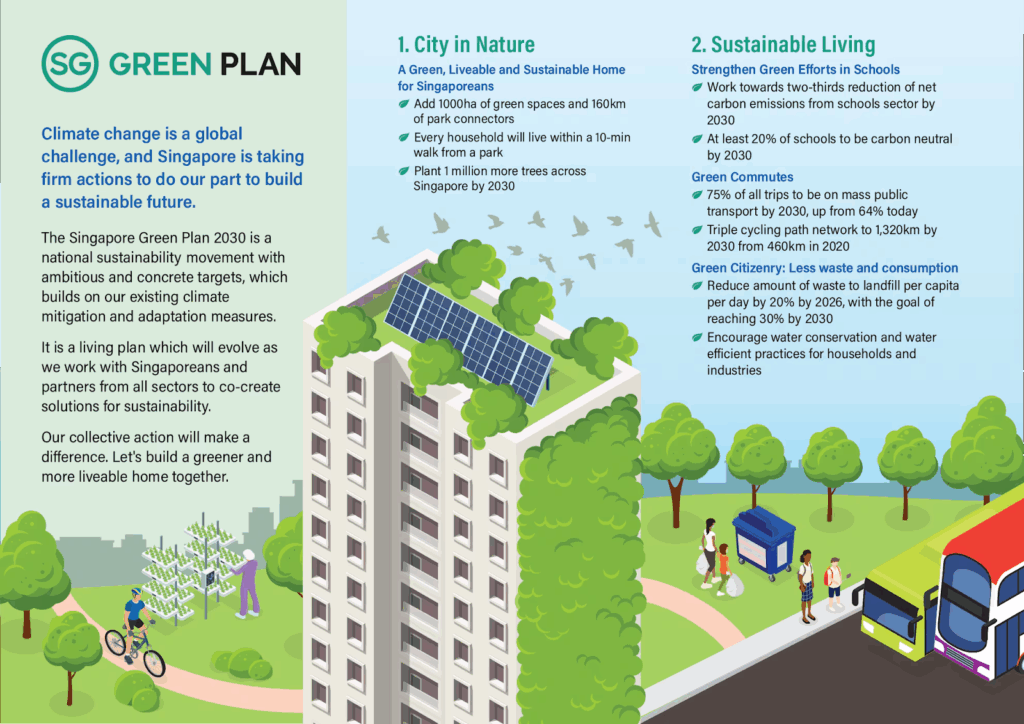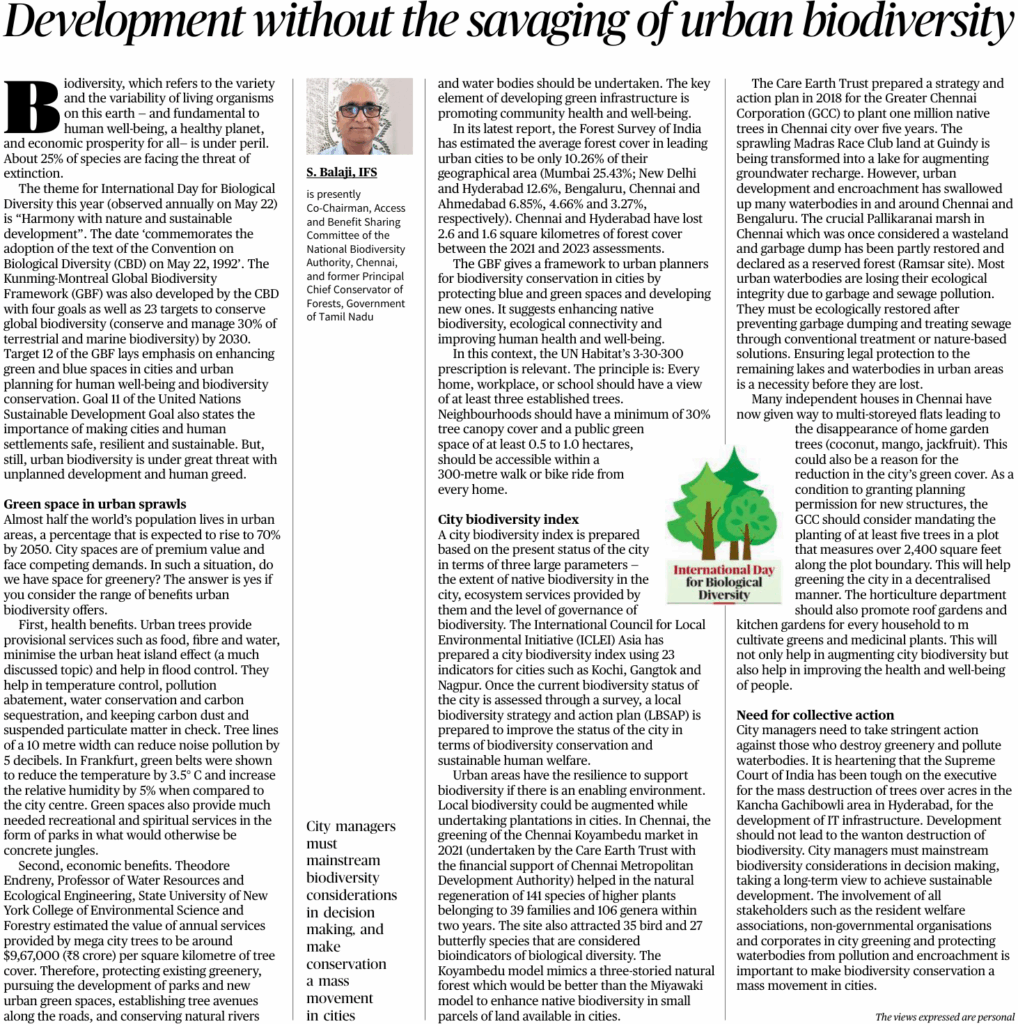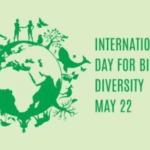Urban Biodiversity and Sustainable Development: A Challenge for India’s Permanent Cities (GS3 – UPSC).
Sustainable urban development isn’t just a planning goal – it’s a constitutional and environmental imperative. Preserving urban biodiversity is vital to resilient infrastructure, inclusive growth, and ecological balance.
Relevance: GS3- UPSC
INTRODUCTION
Cities can only be development engines when breathing with lungs of biodiversity. Urbanisation, the identity of modern civilisation, is often observed as a sign of development. With almost half of the population living in cities, estimated that to will affect 70% by 2050, with rapid economic, social and political activity in urban areas. However, this urban spread quickly reaches a severe organic price. Under pressure of unplanned growth and unstable growth, erosion of biodiversity, not only a threat to flora and organisms, but also the very basis for healthy living and sustainable livelihoods.

- This year’s International Day for Biodiversity, celebrated every year on May 22, bears the subject: “Harmony with nature and sustainable development”.
- It resonates with a global need to cover the development goals with environmental protection.
- Since the world looks at the 2030 Global Biodiversity Framework (GBF) goals and the UN’s goal for sustainable development (SDG), especially the goal 11 (fixed cities and society), the integration of conservation of biodiversity in urban planning is no longer an alternative – it is mandatory.
Urban biodiversity: quiet development of development
- Biodiversity is not limited to rainforests or rural landscapes; It is rich – or once wealthy – in urban areas.
- From the wetlands to the tree, the plan for the road, from the gardens of the house to the urban lakes, the cities historically coexist with nature. However, this relationship deteriorates rapidly.
- Currently, 25% of global species are prone to extinction, and cities are often seen as concrete forests, appearing as one of the prominent contributors in this crisis. Whether it is the destruction of the wetlands for real estate projects or the removal of a tread for expansion of the road, the pressure to accommodate economic ambitions assumes the ecological basis that supports urban life.
Why does urban biological diversity mean

Ecological and health benefits
- Urban-green locations are not decorative luxury – they are organic requirements. Trees, wetlands and gardens provide important ecosystem services:
- Climate control: Trees reduce the effects of the city’s heating island, down the temperature in the city, as seen in Frankfurt, where the green belt has reduced the temperature by 3.5 ° C.
- Pollution control: Green belts absorb the suspension of particulate matter, trap carbon and reduce noise pollution.
- Flood restriction: In the monsoon-exposed regions, such as vegetation aids, Mumbai or Chennai, in water treatment and flood control.
- Mental and physical health: By reducing access to green places, improving social health by reducing stress, encouraging physical activity and increasing social harmony.
- Financial assessment: According to Professor Theodore Andrane, urban trees offer services priced at $ 967,000 (£ 8 crore) per year. These include energy savings (through shade), stormwater processing, carbon capture and better air quality. Yet, despite such com
Forest Survey of India (FSI) painted a worrying picture of green cover in Indian cities:
- Mumbai: 25.43%
- Delhi and Hyderabad: 12.6%
- Bengaluru: 6.85%
- Chennai: 4.66%
- Ahmedabad: 3.27%
- Between 2021 and 2023, Chennai and Hyderabad alone lost 2.6 km and 1.6 km away in forest cover. These disadvantages are not just statistical; They represent the shrinking lungs in our cities.
Solutions and Strategies for Urban Biodiversity Conservation
- Kunming-Montreal Global Biodiversity Framework (GBF)
- The goal of GBF focuses on increasing urban green and blue spaces directly by 2030. 30% of land and marine biodiversity must be preserved through effective governance. It gives cities a roadmap to integrate biodiversity into urban development. 3-30-300 rules for an-habitat
This urban planning prescription provides simple, action-rich guidelines:
- View of at least three trees from each house or workplace.
- 30%: Minimum three canopy cover in each neighbourhood.
- 300 meters: Close to each house for a green place of at least 0.5 to 1 hectares.
- This model ensures equal distribution of green benefits in socio-economic groups and promotes urban-wide biodiversity
The city’s biological diversity index (CBI)
- The International Council for the Local Environmental Initiative (IICLEI), the index uses 23 indicators to measure biodiversity in three domains:
- Presence of indigenous species
- Ecosystem services provided
- Management and protective efforts
- Cities such as Kochi, Gondia and Nagpur have begun to implement CBI, followed by local biological diversity strategies and action plans (LBSAPS) to guide politics and investments.
Case Studies: Learning from the Field
- Coimbedu Bazaar, Chennai: Once a chaotic, crowded area was turned into a biological diversity by Care Earth Trust. Green Initiative LEDs:
- 141 indigenous species
- 35 birds and 27 butterfly species
- This three-story forest model copied natural ecological systems compared to the popular Milwaukee method, which proves the power of indigenous solutions in urban contexts.
- Pallikaranai Marsh: When dismissed as a dump, this Quagmire in Chennai has now received the status of a Ramsar site and a reserved forest. This success emphasises the importance of a social lawyer, ecological restoration and legal protection in reviving urban biodiversity.
- Gundi Lake Change: An effort is underway to convert the Madras Race Club country into a lake for charging groundwater. Such measures not only restore ecosystems but also protect important urban resources.
Challenges for the preservation of urban biological diversity
- Interventions: Wetlands and lake beds, especially in cities such as Bengaluru and Hyderabad, have large illegal constructions.
- Pollution: The flow of sewage, plastic waste and industrial discharge reduces the ecological integrity of the water body.
- Disadvantages of home garden: When the independent houses cope with multi-floor apartments, coconut, mango, and jackfruit trees disappear.
- Politics interval: Urban planning rarely integrates the preservation of biodiversity into core laws or infrastructure projects.
Political recommendations and forward
- Legal mandate and planning reform: Mandate Tree Plantation: Urban authorities such as Greater Chennai Corporation (GCC) should add permission from the building authorities to the requirements for wooden plantation on large plots.
- Protect blue-green corridors: Protect natural water bodies through regulatory rules and legal buffers. Restore the wetlands using nature-based solutions: Instead of engineering-ambitious solutions, use wetlands, biotstreams and phytoramnia.
- Community engagement and consciousness: Encourage residents’ RWAS to gain ownership of green places. Promote roof gardens and kitchen gardens through supplements and training from horticultural departments. Include students, voluntary organisations and companies in biological diversity surveys, plantation stations and clean-up initiatives.
- Strengthen control and enforcement: Strict punishment for illegal tree felling and intervention in the water body. Regular monitoring is required when using GIS and remote measurement technologies. To build urban biological diversity cells into municipal organs to integrate ecological approaches into each project.
- Legal activity as a catalyst: Recent decisions from the Supreme Court, such as preventing the destruction of trees in the Gachibovali in Hyderabad, reflect the increasing legal concern for urban ecology. Such intervention can catalyze systemic reforms when complemented by executive action.
Conclusion
The idea that the development and preservation of biodiversity are mutually exclusive, a myth for dividends, is long overdue. When climate change is intensified and multiplied by urban health crises, cities should look inward for solutions. Biodiversity is not a beauty secondary – it is scaffolding in life, even in a metropolis.
Also Read : India’s rising e-waste, the need to recast its management







